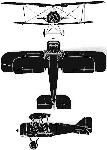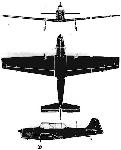Фотографии
-
PORTUGUESE HURRICANE IIc has rarely been illustrated, although several returned to the United Kingdom to be repainted as Mark Is for the air sequences in the Battle of Britain film "Angels One Five". The red and green fin flash of the Portuguese air force can just be discerned.
Самолёты на фотографии: Hawker Hurricane - Великобритания - 1935
-
Регистрационный номер: G-AOJA VICKERS VISCOUNT SERIES 800. The Vickers Viscount 800 series was developed as a bigger, more economical development of the famous V-700 series, for operation over relatively short, high-density inter-city routes. The prototype, a V-802 registered G-AOJA, made its first flight at Weybridge on 27th July 1956, and appeared at Farnborough in B.E.A. colours, named R.M .A. Sir Samuel White Baker. Twenty-four 65-seater V-802s have been ordered by B.E.A. and a further fourteen of a later type. The first four, after AOJA, are already on the production line. Other 800 series aircraft have been ordered by Aer Lingus, K.L.M., New Zealand National Airways and Transair. The series will be developed, during 1958 and 1959, into the V-810/840, externally similar, but powered with the R.Da. 7/1 and 8 respectively.
Salient features : The V-800 is complementary to, rather than a replacement for the V-700 series, and differs from the latter in several respects. The fuselage has been increased in length by 3 ft . 10 in., and this, together with a backward movement of the aft pressure bulkhead, has resulted in a cabin 9 ft. 3 in . longer, enabling a maximum of seventy passengers to be accommodated over the fifty-three of the V-700. The doors have been redesigned and are rectangular, rather than oval. The Rolls-Royce R.Da .6 Type 510, which powers the V-800, is a turbo-prop with two-stage turbine and centrifugal compressor, and has been developed from the Dart.Самолёты на фотографии: Vickers Viscount - Великобритания - 1948
-
ViCKERS VISCOUNT SERIES 800. Data : Manufacturer : Vickers Armstrongs (Aircraft) Ltd., Weybridge. Powerplant : four Rolls-Royce Dart R.Da.6 Type 510, giving 1,600 s.h.p. plus 370-lb. thrust, totalling 1,780 e .h.p. at 14,500 r .p.m. Accommodation : fifty-two-seventy passengers. Dimensions: span 94 ft.; length 85 ft .; height 26 ft. 9 in . Weights : loaded 62,000 lb .; max. payload 12,700 lb . Performance: cruises at 320 m.p.h . with maximum payload. Range : 620 miles under conditions given.
Самолёты на фотографии: Vickers Viscount - Великобритания - 1948
-
Регистрационный номер: LN-DBW, LN-HAO, LN-PAE, LN-RAD NORDIC SEA BOOTS. Reader L. Wilkins queries the size of Cub floats and whether many European aircraft are fitted with floats. The accompanying photograph should satisfy most flotation gear enthusiasts. Taken in 1950, near Oslo, the aircraft are (left to right) Noorduyn UC-64A Norseman (LN-PAE); Fairchild UC-61K Forwarder or Argus III (LN-HAO); the sole Norwegian Honningstad C-5 Norge (LN-DBW) and Piper L-4J Cub (LN-RAD) . The two black and white buoys were once German sea mines.
Самолёты на фотографии: Fairchild C-61 Forwarder / Model 24 / Argus - США - 1932Honningstad / Wilderoe C.5 Polar / Norge C - Норвегия - 1948Noorduyn C-64 Norseman - Канада - 1935Piper Cub J-3/J-4 / L-4 Grasshopper / PA-11 - США - 1937
-
Регистрационный номер: G-EBQU ORIGINAL TIGER MOTH. Called Tiger Moth. the de Havilland D.H.71 of 1927 was a single-seat (research) racer powered by a Blackburn Cirrus II in-line. The prototype, G-EBQU (illustrated), had an a.u .w. of 905 lb . for a span of 22 ft. 6 in . and length of 18 ft. 7 1/2 in. Construction was all wood. A second D.H.71, G-EBRV, was powered by a 130-h .p. D.H. Gipsy in-line . Piloted by the (then) C.T.P. Capt. Hubert Broad, the D.H.71 set up a new closed circuit 100-km. speed record at 186.47 m.p.h. and five days later (29th August 1927) raised the appropriate British height record to 19.196 ft.
Самолёты на фотографии: De Havilland Tiger Moth / D.H.71 - Великобритания - 1927
-
Регистрационный номер: N395B NEW BEECH TWIN is the Model 95 Badger, first deliveries of which will commence in 1957. Built at Wichita, Kansas, the Model 95 Badger seats four and has an approximate cruising speed of 200 m.p.h. Power is two 180-h.p. Lycoming flat-sixes. Prototype is N395B illustrated. Other data is not yet available.
Самолёты на фотографии: Beechcraft Model 95 Travel Air - США - 1956
-
Регистрационный номер: G-ANVP, N340EL NAPIER ELAND CONVAIR. In November 1954. D. Napier and Sons. Ltd ., purchased N8458H, a standard Convair 340-D2 with Pratt and Whitney R-2800-CB16 engines of 2.400 h.p. which were replaced by Napier Eland engines. Conversion was completed in two months, and G-ANVP made her first flight with the new engines on Thursday, 9th February 1955.
Salient features: The airframe is that of a standard Convair 340, and the engine nacelles have been removed forward of the fireproof bulkheads to accommodate the slightly longer Elands.Самолёты на фотографии: Convair CV-540/CV-580/CV-600/CV-640 - США - 1955
-
NAPIER ELAND CONVAIR. Data: Manufacturer: The Convair Division of General Dynamics Corporation. San Diego, Cal., and D. Napier and Sons. Ltd ., Acton. Powerplant: two Napier Eland N.E1.1 turboprops driving 13 ft. 6 in. de Havilland Hydromatic, four-bladed propellors with reversible pitch. Dimensions: span 105 ft. 4 in ., length 79 ft. 2 in ., height over tail 28 ft. 2 in. Weights: 27.286 lb. empty. 44.800 lb. all-up. Performance: cruising speed about 335 m.p.h.
Самолёты на фотографии: Convair CV-540/CV-580/CV-600/CV-640 - США - 1955
-
Регистрационный номер: CF-DIO EXPERIMENTAL RUDDER on the prototype de Havilland (Canada) DHC-1 Chipmunk two-seat primary was one of three/four shapes tried before the final curved line, familiar today, was adopted. This photograph was taken at the Toronto factory about a month after the first flight in May 1946.
Самолёты на фотографии: De Havilland Canada DHC-1 Chipmunk - Канада - 1946
-
Регистрационный номер: VH-ULX KOOLHOVEN F.K.41 was a three-seater produced in the Netherlands in the late 1920s; also built in the U.K. (about forty) by the Desoutter Company. Normal engine was the Cirrus Hermes I, but VH-ULX (c/ n. 4103, crashed 10th November 1937, Condobolin, N.S.W.) was powered by a 90-h.p. D.H . Gipsy II. Two F.K.41s were on the British Register : G-AAGC and G-AALI (c/ n. not known). Former sold to S. Africa ; latter "sold abroad " (October 1929) may have become VH-ULX.
Самолёты на фотографии: Koolhoven FK-41 - Нидерланды - 1928
-
Регистрационный номер: G-AUIX RYAN BROUGHAM (c/ n. 148) photographed in India in 1928 on an unsuccessful Australia-England record attempt. G-AUIX (AU - Australian Register) was totally destroyed as the result of a crash in Greece. From the Brougham was developed the famous Lindbergh Atlantic crossing "Spirit of St. Louis" (N-X-211), the Ryan NYP - the Brougham in turn being developed from the 1926 M-2 Bluebird.
Самолёты на фотографии: Ryan B-1 Brougham - США - 1927
-
Регистрационный номер: G-EAYN GLOSTER G.11 GROUSE Mk.II. Conceived by the late H. P. Folland, the two-seat Gloster Grouse of 1923 laid the foundation for the later Grebe single-seat biplane fighter. Designed as a P.V. (Private Venture) experimental machine, the Grouse incorporated a special wing combination of high-lift section upper main plane and medium high-lift lower mainplane. The test machine was basically a modified Nighthawk (Mars) with the new wings which permitted a reduction in total wing area of 62 sq. ft. The wing combination was given the designation Gloster H.L.B. Section. Fitted with a 230-h.p. Bentley B.R.2 radial in a close cowl, this experimental machine (G-EAYN) was demonstrated at Hendon aerodrome before Air Ministry officials.
The demonstration successfully showed the increased manoeuvrability of the smaller span wings and as a result an order for three Grouse was placed. These were powered by the Armstrong Siddeley Jaguar III radial engine. The Mk. I was also fitted with a 200-h.p. Bristol Titian. The Mk.II Grouse of 1924 was fitted with an uncowled Armstrong Siddeley Lynx of 185 h.p. With two seats in tandem and dual controls the Grouse Mk. II replaced the Avro Type 504K.Самолёты на фотографии: Gloster Grouse - Великобритания - 1923
-
GLOSTER GROUSE Mk.I. Data: Manufacturer: Gloster Aircraft Co. Ltd ., Hucclecote, Glos. Grouse Mk. I (see silhouette) Bentley B.R.2. Grouse Mk. II (see photo) Armstrong Siddeley Lynx. Grouse Mk. I: span 27 ft. 10 in.; a.u.w. 2.106 lb.; max. speed 128 m.p.h.; stalling speed 47 m.p.h.; climb to 10.000 ft. 11 minutes; service ceiling 19.500 ft.
Самолёты на фотографии: Gloster Grouse - Великобритания - 1923
-
Регистрационный номер: IX490 HINDUSTAN HT-2. The first prototype Hindustan HT-2 flew for the first time on 13th August 1951. This machine was registered VT-DFW and carried the prototype P. The second prototype aircraft, VT-DFY first flew on 19th February 1952 and had the shape of the fin and rudder altered considerably to increase the chord, a feature retained on production machines. The HT (Hindustan Trainer)-2 is the possessor of the Government of India's first Type Certificate, issued on 20th December 1952, and besides the prototype aircraft there were several military machines flying at that time. The first six production aircraft were delivered to the Indian Air Force towards the end of January 1953 .
Salient features : The HT-2 is of stressed all-metal construction, with semi-monocoque fuselage and two-spar wing. All covering is metal. The fixed oleo-strut undercarriage is attached to the front wing spar, and features hydraulic brakes. Full equipment includes an electric starter and all controls and instruments are duplicated.Самолёты на фотографии: HAL HT-2 - Индия - 1951
-
HINDUSTAN HT-2. Data: Manufacturer : Hindustan Aircraft Ltd., Bangalore, India. Powerplant : one Blackburn and General Aircraft Ltd . Cirrus Major Series III of 155 b.h.p . Accommodation two. Dimensions: span 35 ft. 2 in ., length 25 ft . 2 1/2 in ., height 8 ft. 11 in . Weights : empty, 1.600 lb. Loaded 2,240 lb . Useful load 640 lb. Performance : max. speed at sea-level 130 m.p.h.; cruising speed 115 m.p.h. Rate of climb at sea-level 800 ft. /min. Service ceiling 14.500 ft. Range 350 miles. Endurance cruising 3 1/2 hrs. Tankage 26 gallons.
Самолёты на фотографии: HAL HT-2 - Индия - 1951














